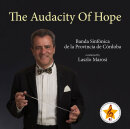| Besetzung: | Blasorchester |
| Komponist: | Alberto Williams |
| Arrangeur: | Miguel Etchegoncelay |
| Grad:Schwierigkeitsgrad: | 3 (mittelschwer bis schwer / Mittelstufe) |
| Genre: | Klassik, Konzertwerk |
| Dauer: | 04:08 |
| Stimmen:Enthaltene Stimmen: |
|
| Format: | DIN A4 |
| Verlag: | Star Music Publishing |
| Kategorie: | Konzertwerke |
Cortege Champetre is the fifth piece of a piano series entitled En la Sierra, op. 32 (In Hill Country) from Argentinian composer, pianist, pedagogue and conductor Alberto Williams. The five movements integrating this collection, each one of them in their own unique style, were published in 1893. They earned widespread success, especially the fourth "El rancho abandonado" (The Abandoned Hut), which is a nostalgic lament of rural life in the pampas. Although the different movements bear titles such as "La colina sombreada" (Hill in shadows) or "Insectos y lagartijas" (Insects and lizards) and would suggest some kind of descriptive music, Williams remains attached to an international style strongly rooted in the Romantic tradition that he mostly cultivated during the 1890s and early 1900s, avoiding any kind of elements taken from Argentina's folk music.
This is also evident in Cortege. Crafted in binary form, the piece opens with a strong statement in the key of Bb major, fanfare like, using blocks of chords exploring the whole range of the piano. The orchestral sound intended by Williams unmistakable suggest a large tutti in a maestoso character. The second section, in Gb major, follows without preparation. A sweet, cantabile melody accompanied by broken chords in a simple homophonic texture introduces us to a country like atmosphere, then rapidly the first section returns, as a coda, to end the piece as it began. After his education in Buenos Aires, Williams received a scholarship to study music composition at the Paris Conservatoire, where he was mentored by Georges Mathias and Charles de Bériot in piano, Emile Durand in harmony and Ernest Guiraud in counterpoint. He furthermore took private lessons in composition with César Franck. Besides piano music, Williams composed nine symphonies, three orchestral poems, two concerts overtures, songs and chamber music. He is regarded as the father of Argentinian music, author of numerous texts on music theory and other aesthetic and historical topics.












